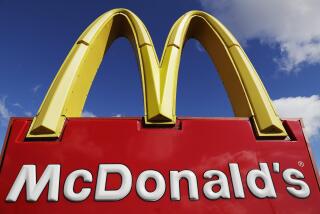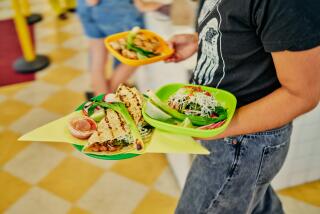Past Perfect? : Days When People Found Ground Round for 15 Cents a Pound Sound Too Fine
- Share via
NOW AND THEN in fits of nostalgia, I have recalled the price of tomatoes or champagne or some other staple during the Depression 1930s, suggesting, I suppose, that those were the good old days.
Robert Michaels, an economist, writes to reproach me for such a misconception, pointing out that prices were related to income, so things were really no cheaper than they are today.
“Why do so many people think of such prices with affection?” he asks. “Why not write a column which describes how bad the old days were because people’s incomes were so small in dollar terms relative to nowadays?”
Michaels points out that when we pay inflated prices for something, we inflate the incomes of those who produced it. So in a relative sense, things were no cheaper in the good old days than they are today.
Well, I’m no economist, but of course I know that. My memories of being poor during the Depression are just as vivid as my memories of five-cent hot dogs.
I have a menu for the Trocadero, a ritzy night club on the Sunset Strip. It is dated Oct. 13, 1934. That night’s entres included soft-shell crabs belle meuniere , $1.40, veal chops sautees a la Viennoise , $1.45, and chateaubriand for two, $4.
Cheap as those prices seem today, they effectively barred me from patronizing the Troc. In 1934 I was an usher in the Stadium Theater on Pico Boulevard, making, as I remember, about $17 a week for six nights’ work. A dinner that might cost as much as $6 of $7, for two, was out of the question.
My file also yields a menu for Sebastian’s Cotton Club, which was, I believe, out on West Washington Boulevard in Culver City, dated June 15, 1935. The filet mignon dinner de luxe--with celery, hors d’oeuvres, soup, spaghetti, potatoes, vegetables, salad, ice cream and coffee--was $2.50.
A reader who used to work in the Fresno canneries in 1934 sends a menu from Omar Khayyam’s Fresno restaurant of that era. Cocktails were 25 cents. Wine was 15 cents a glass. The special luncheon--with soup, salad, pasta, entree, desert and tea or coffee--was 45 cents. The special luncheonette was 35 cents. But at that time my correspondent was making 30 cents an hour.
A physician who entered practice in 1936 recalls that an office visit cost a patient $2, house calls were $3 and night calls $5. Babies were delivered at home for $15, an appendectomy cost $75 and a hospital room $4 a day.
In 1930, he recalls, he worked hard after school to save $5 with which to impress his girl friend with dinner at the Coconut Grove in the Ambassador Hotel. That was the cost of dinner for two.
It was cheaper, of course, to eat at home. A Safeway ad in The Times of July 26, 1935 lists round steak at 24 cents a pound, premium sliced bacon at 19 cents a half-pound, 10 pounds of potatoes for 13 cents and four bottles of Brown Derby beer for 29 cents.
Veterinary medicine was similarly inexpensive. Dr. A. E. Joseph, of the Lynwood Dog and Cat Hospital, would spay or castrate a dog or cat for $1, a rabies vaccine cost $2 and dogs could be boarded for $3.50 a week, cats for $3.
A reader writes that in 1933 Dr. Joseph spayed his wife’s fox terrier, Mickey, for $1, and that Mickey lived to be 18.
In the spring of 1933, the year of the Long Beach earthquake, I was living in Long Beach with my older sister. She was supporting my mother and me on the $25 a week she made as a vocal soloist on a sustained (non-sponsored) radio show on KFOX. (She had a gorgeous contralto voice.)
As an example of how dear money was, I recall the time she gave me a $10 bill to buy some hamburger at the market. The butcher wrapped the pound of hamburger, which probably cost 15 cents, and I gave him the $10. He gave me a handful of coins and I went home, daydreaming as usual. My sister was shocked. I had come home with change for $1, instead of $10. The difference would feed us for a week. l ran back to the market, thinking this was surely the darkest day of my life. I knew the butcher would deny that I had given him a ten. How could I prove it? But he looked in his $1 box and said, ‘You’re right. Here it is,” and counted out my change--$9 in $1 bills.
So it’s true that only the well-to-do could afford the Trocadero and the Coconut Grove. But there was a quality of life in those days that does not seem so prevalent today. We were poor but honest. We didn’t cheat our neighbors.
That’s something to feel nostalgic about.
More to Read
Eat your way across L.A.
Get our weekly Tasting Notes newsletter for reviews, news and more.
You may occasionally receive promotional content from the Los Angeles Times.










